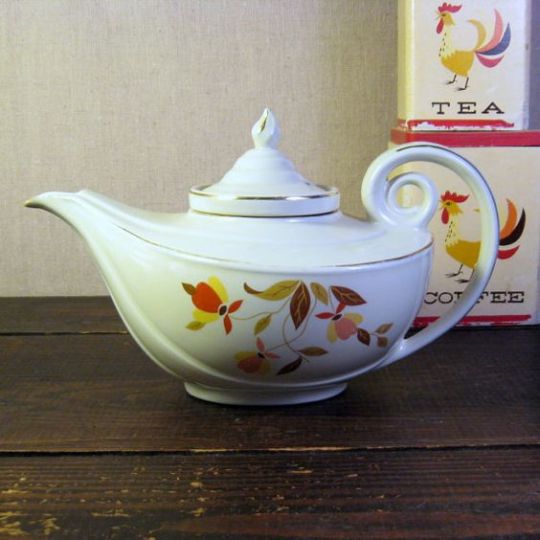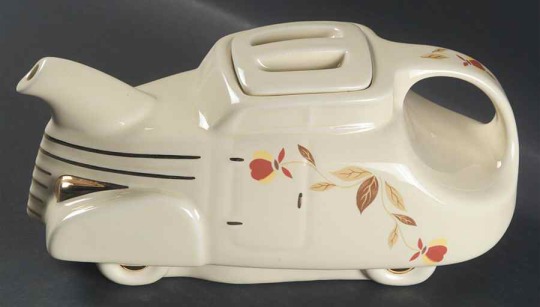#grocerystorechina
Explore tagged Tumblr posts
Text
Vintage “Autumn Leaf” Jewel Tea China
Fall is the perfect time to take a look at “Autumn Leaf” kitchen and tableware. This very popular china pattern was made for the Jewel Tea Company. Based in Chicago, Illinois, the company reached customers across the United States through salesmen and mail order catalogs from 1901 through 1983.
I became aware of Autumn Leaf china through my friend Rozann, whose mother had beautiful bowls in this pattern. My mother-in-law also has a few treasured Autumn Leaf pieces. From them, I came to love and appreciate this line, and decided to explore its history.

Hall Autumn Leaf “Aladdin” teapot, circa 1950s or 1960s. It bears the Mary Dunbar mark, and includes a gold-trimmed tea insert.
Jewel Tea’s founder, Frank Vernon Skiff, wanted to bring the public coffee and tea that was fresher than much of what was available at the time. Spices were soon added, with the same promise of freshness, and customers began requesting other basic goods. By 1916, there were 1,625 Jewel Tea delivery routes across the country. The company was very good at responding to consumer demand, and by 1926 Jewel carried 50 different products, including laundry and toiletry items.

“Mary Dunbar’s Favorite Recipes,” an 80 page cookbook published for Jewel Tea customers. Recipes incorporated ingredients sold by Jewel. It is un-dated, but likely from the 1930s. From my personal collection.
Jewel Tea had its own product testing and quality control department, run by “Mary Dunbar,” the name used by the director of the Jewel Homemakers’ Institute. It began in 1924 with Mary Hartson, whose maiden name was Dunbar. The name became a job title, used by all directors who followed. The Jewel Homemakers’ Institute tested and approved grocery items and housewares for its customers. In 1926 Jewel published the first “Mary Dunbar” cookbook, featuring recipes containing Jewel ingredients. These books proved very popular, and are still collected. But in 1933, in the depths of the Great Depression, something even more sought-after was introduced.
Jewel Tea began offering gold-trimmed ivory Hall china in a pattern referred to as Hall, Jewel, Autumn, or Autumnal, then later Autumn Leaf. It started in 1933 with a bowl used as a premium for customers. Times were hard, and salesmen found the premium encouraged business. (The design had originated in the 1920s, but became exclusive to Jewel Tea by Hall in 1933.) A variety of other pieces followed, including coffee pots, teapots, canisters, custard dishes, casseroles, salt and pepper sets, dinnerware, bain marie jars, and much more. While many of these items came and went, a three-piece set of china mixing bowls was consistently made and sold from 1933 to 1976.
Although the china pieces are best known, Jewel Tea also had the Autumn Leaf pattern printed on tablecloths, aprons, shelf paper, flour sifters, and other housewares. Hazelware produced coordinating Autumn Leaf glass tumblers. (Later Libbey made glass Autumn Leaf tumblers, plates, and candy dishes.) Autumn Leaf Melmac dishes were produced in 1960, the heyday of melamine dinnerware.
Autumn Leaf china went into more households as the Jewel Tea Company grew. In 1949, customers in small towns received deliveries on 1,876 routes in 43 states, while larger population areas were served by 154 company-owned grocery stores. (Rozann’s mother remembered Autumn Leaf as a grocery store premium.) More stores were added but home deliveries continued, and by 1981, when Jewel divested itself of its “Jewel Home Shopping Service,” they still had 1,000 delivery routes in 42 states.
Different potteries produced pieces in this pattern: Hall China Company of East Liverpool, Ohio; Crooksville China Company of Crooksville, Ohio; Harker Potteries of Chester, West Virginia: and Paden City Pottery, Paden City, West Virginia. (There are also imitations of Autumn Leaf, generally of poorer quality.) Hall China Company made pieces in the Autumn Leaf pattern until 1978. Autumn Leaf china is now made exclusively for the National Autumn Leaf Collector’s Club.
Age of pieces can be determined by the marks. Help with general dating of Hall China is available online. Collector’s guides are available in print and online, The National Autumn Leaf Collector’s Club website is also an excellent resource for everything from finding pieces to caring for them.
Because Autumn Leaf was produced for decades, good examples are generally easy to find, especially on sites like eBay and Etsy. As with everything collectible, rarer pieces command higher prices. Luckily, you can still obtain beautiful, functional pieces, such as mixing bowls and dinnerware, at reasonable prices.

Hall Autumn Leaf Mary Dunbar bowl. The bottom is marked HALL`S SUPERIOR and shows it was tested and approved by Mary Dunbar, Jewel Homemakers Institute. “Mary Dunbar” was the the name used by he director of the Jewel Homemakers’ Institute, starting in 1924 with Mary Hartson, née Dunbar. Jewel Tea tested grocery items and housewares for its customers, and produced cookbooks that are also highly collected. When china was introduced, the Institute’s approval was part of the back stamp.

Hall Autumn Leaf rayed 9-cup coffee pot, with the Mary Dunbar backstamp. My mother-in-law has one just like this.

Hall Autumn Leaf dinner plate. The Mary Dunbar stamp of approval is shown below.

Hall/Mary Dunbar backstamp on the dinner plate.

Libbey Autumn Leaf 12 ounce glass tumbler, 1993. Photo from the Replacements, Ltd web site.

Hard-to-find Hall Autumn Leaf automobile teapot. Photo from the Replacements Ltd web site.
.
#autumnleaf#hallchina#hallautumnleaf#jeweltea#marydunbar#jewelhomakersinstitute#nationalautumnleafcollectorsclub#lhazel glass#hazelware#libbey#libbey glass#melmac#melamine#delivery routes#jewelhomeshoppingservice#grocerystorepremium#grocerystorechina
1 note
·
View note